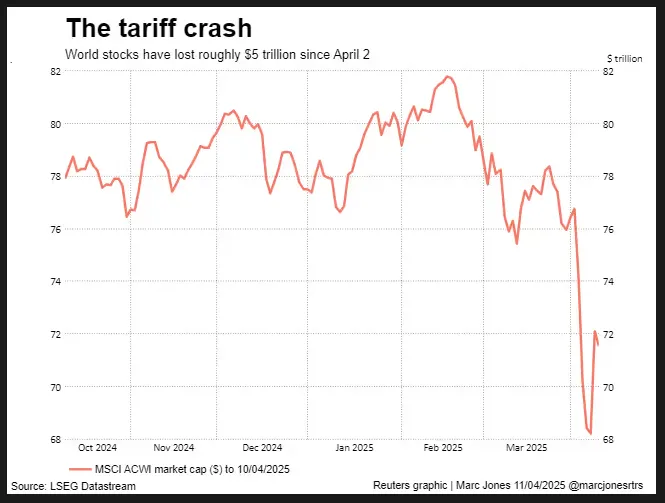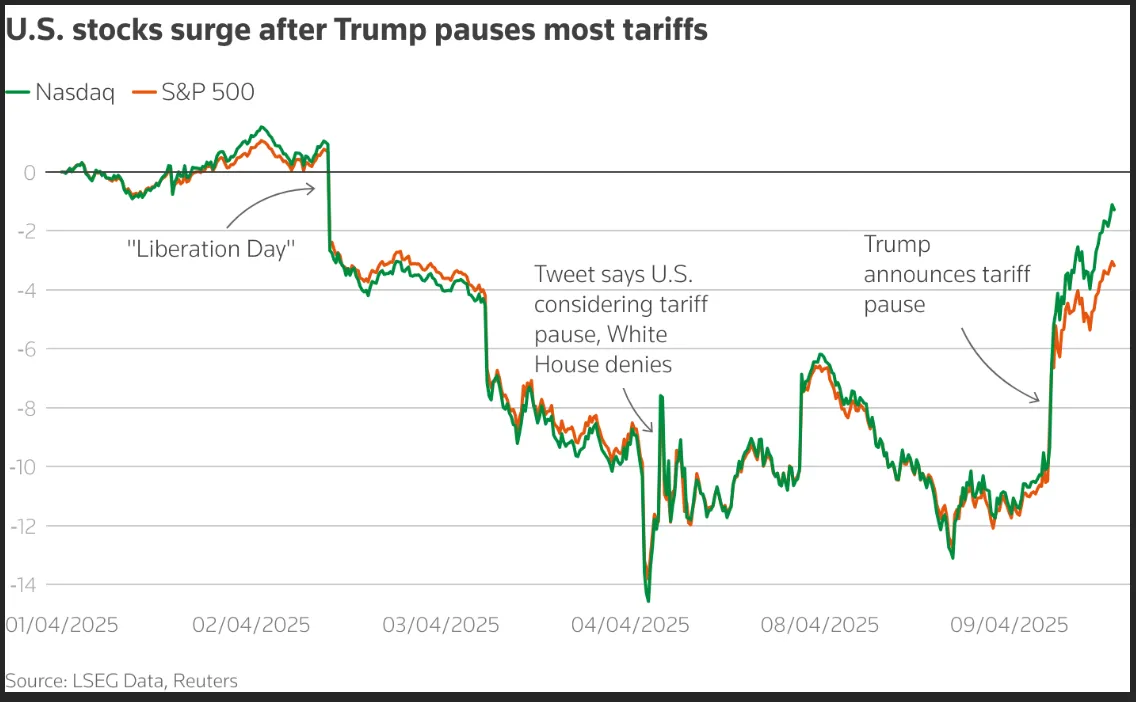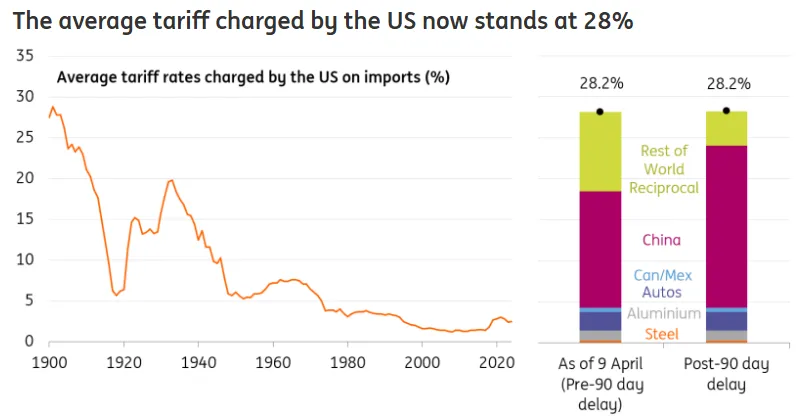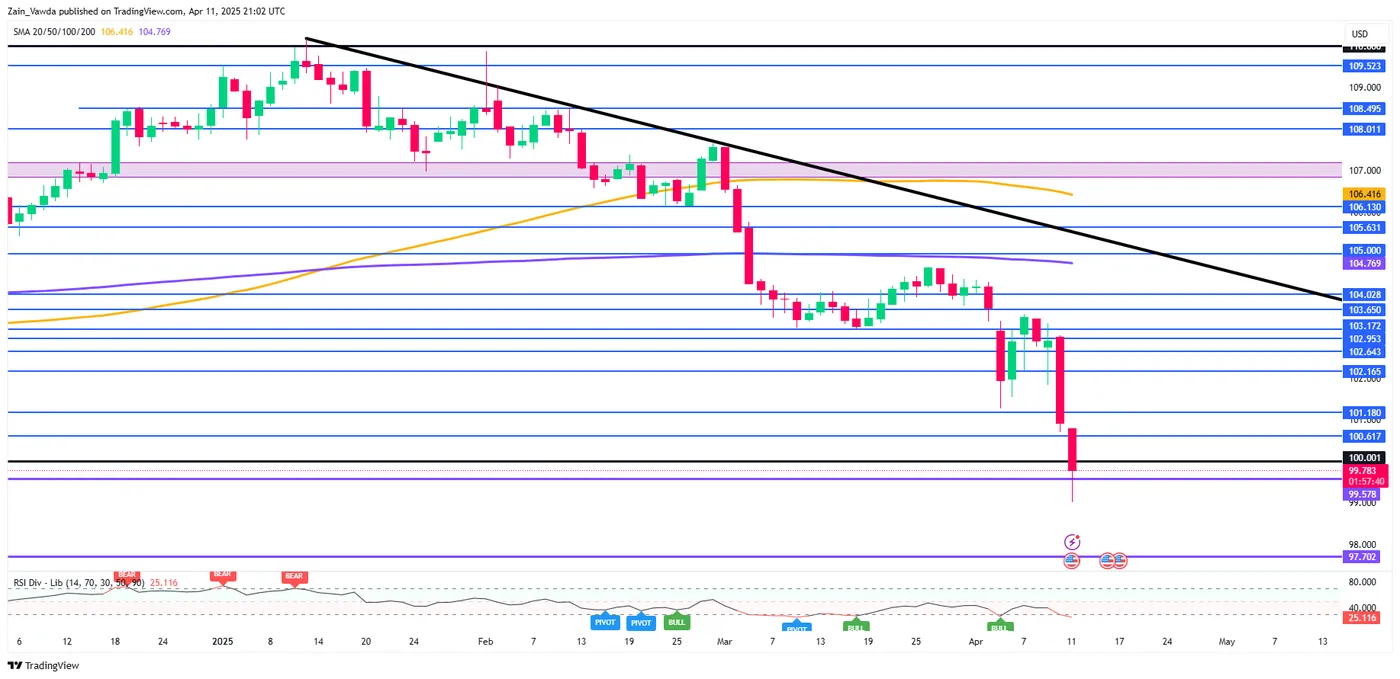- US dollar weakened amid market concerns, hitting 2022 lows.
- Tariff changes and global economic fears drive market volatility.
- Gold prices surge, while oil faces losses due to supply and demand issues.
- The upcoming week focuses on US tariffs, inflation data, and the ECB meeting.
It’s been a wild ride, to say the least, for financial markets this week. Wild swings, multi-year highs and lows being tested, tariffs being pulled back and of course, the escalating tensions between the US and China.
The developments this week necessitate us to start with FX markets as the {8827|US dollar}} endured heavy losses, hitting 2022 lows in the process.
The FX market tells an interesting story. Among G10 currencies, only the less-traded Norwegian krone hasn’t moved against the dollar since last Friday. Other currencies have gained, with the pound up 0.8%, the euro, Australian dollar, and New Zealand dollar rising 2-3%, and the Swiss franc leading with a 4.5% increase.
Markets are clearly telling us that there is a crisis of confidence in the US dollar at the moment. Whether I believe there should be or not is an entirely different and irrelevant discussion given what we have already seen from markets.
On Thursday, we saw investors move away from US assets. Both stocks and Treasury bonds dropped, even though core inflation came in much lower than expected (0.1% instead of the predicted 0.3% for the month).
Markets are telling us that data is not the main driving force behind market moves. This honor is taken by concern about the combined threat of inflation and growth deceleration.
A perfect example of the challenges facing global markets is reflected in the losses for stock markets around the world.
More than $5 trillion in market value has vanished from the MSCI all-country index of world stocks during the roller-coaster ride since April 2.

Source: LSEG
These developments have helped Gold prices once more, with the precious metal making multiple fresh highs this week. Gold peaked on Friday at around $3245/oz at the time of writing. The precious metal is on course to finish the week around 6.5% up
Oil prices rose on Friday, but both Brent and WTI are set for a second consecutive week of losses. Tariffs, as well as recessionary fears, are impacting oil demand forecasts just as OPEC + increased output. Earlier today, President Trump’s administration said the President wants the US to pump more and more oil, further exacerbating demand and supply dynamics.
US Equity Indexes finished the week on a positive note with the Dow Jones increasing by 648.65 points (1.64%) to 40,242.31. The S&P 500 went up 93.70 points (1.78%) to 5,361.75, and the Nasdaq climbed 312.92 points (1.91%) to 16,700.23. The week was a positive one for US stocks following President Trump’s pause on his ‘liberation day tariff agenda’.
The move has seen US indexes recover most of the losses which occurred since the April 2 announcement.
Source: LSEG
The biggest story this week, aside from the US dollar, comes from the US Treasury market. US 10-year Treasury yields saw their biggest weekly jump in over 20 years on Friday. Rumors of selling, or lack of buying, by foreign investors are adding to concerns over the market with rumors that hedge funds and asset managers were getting margin calls.
Another reason cited for the performance comes through the unwinding of basis trades, a strategy where investors earn from the gap between cash Treasury prices and futures. Many believe this is a large factor behind this week’s volatility.
An interesting take from ING THINK caught my attention this week. To summarize, the piece opined that U.S. tariff policies haven’t changed much overall. Here’s why:
Before Trump took office, the average U.S. tariff on imports was 2.5%. By Wednesday morning, with actions like 25% tariffs on metals and autos and up to 50% on China, that average rose to 28%—the highest since the early 20th century.
Midweek, some countries like the EU and parts of Southeast Asia saw their tariffs drop to 10%. However, China’s tariffs, already high at 104%, jumped to 145%. These adjustments balanced out, leaving the average tariff rate unchanged at 28%.
Source: US Census data, White House, ING calculations
**Only non-USMCA-compliant goods from Canada and Mexico are subject to a 25% tariff. Assumes latest China tariff of 145%, as per latest Bloomberg reports. Colored bars show the contribution to the latest average tariff rate from the tariffs charged on different countries and products.
I found this to be an interesting take and something I had partly anticipated, having paid attention to President Trump’s previous term. However, it does not hold much weight in the current climate as markets are still moving and that is the reason why we are here after all.
The Week Ahead: Shortened Trading Week Brings a Host of Data Releases
The upcoming week will focus on U.S. President Donald Trump’s plans for new tariffs. Alongside this, markets will also watch US jobs data, an Australian central bank meeting, and a key eurozone inflation report.
Asia Pacific Markets
The main focus this week in the Asia Pacific region will be Japanese inflation and a host of data releases from China.
In Japan, inflation is expected to rise, but the Bank of Japan (BoJ) is likely to keep its rate cuts on hold. Goods being shipped early to the US are expected to boost machinery orders and exports.
However, this positive trend might not last beyond the first quarter due to tariff uncertainties. Consumer prices are predicted to go up in March, mainly due to higher service costs. Earlier fresh food price hikes are also expected to show up in eating-out and processed food costs. The BoJ will keep a close eye on how US tariff policies affect the economy while maintaining current rates for now.
It’s a busy data week in China as the country grapples with the escalating trade war with the US. None of the tariffs so far are expected to show any impact on the data yet, but they should do so moving forward.
China will release key data for March, including first-quarter GDP on Thursday. A 5.3% year-on-year growth is expected, though this is before tariffs start impacting from the second quarter. For now, domestic activity seems steady, with retail sales and industrial production likely to grow by 4.5% and 6.0%, respectively.
Fixed-asset investment is expected to stay mostly stable at 4.0%. Trade is slowing as tariffs take effect, but bigger impacts may come later.
Property prices will also be watched to see if market volatility has pushed them down further. Supporting domestic demand is the focus this year, though falling home prices make it hard to boost household confidence. While prices in major cities have stabilized, it’s unclear if this is the bottom.
Meanwhile, all attention is on how China will respond to the 145% tariffs imposed by Trump with a 125% tariff on US goods due to start on April 12.. The market expects possible rate cuts, lower reserve requirement ratios (RRR), and new fiscal policies to support domestic demand.
In the Pacific region, we have some high-impact data from both Australia and New Zealand. On Tuesday, we have the RBA minutes, followed by Wednesday’s New Zealand CPI release. The week ends on Thursday with employment data out of Australia.
Europe + UK + US
In developed markets, the US is enjoying a bit of a data break next week, but the tariff conversations will remain at the forefront. The Euro Zone and the UK have a bit more to offer on the data front next week with the ECB interest rate meeting taking center stage.
The US is expected to have a calmer week due to Easter, but challenges remain. Tariffs have been delayed by 90 days, yet price hikes are still looming. Households are dealing with three key issues: higher prices reducing spending power, job loss fears due to federal budget cuts, and stock market drops making people cautious about major purchases.
March retail sales are likely to show strong growth as consumers rushed to buy before tariffs take effect. Auto sales rose 10.6%, and credit card data points to high demand for electronics and appliances. This may keep GDP growth positive in the first quarter, but future weakness is a concern.
Industrial output will be under the spotlight as Trump pushes for reshoring. However, unclear trade policies and fears of retaliation are making businesses nervous. Meanwhile, the Fed is expected to cut rates by around 90 basis points this year, with three or four 25bp cuts looking likely.
The rise in employers’ national insurance could slow the job market, but so far, redundancy data hasn’t increased. Watch for any drop in job vacancies or payroll numbers, though it seems unlikely.
Lower petrol prices may slightly reduce overall inflation in March, but services inflation is unlikely to fall much yet. More improvement could come in the second quarter if annual price adjustments are less steep.
This is why the Bank of England may continue cutting rates each quarter through 2025 and into 2026.
Chart of the Week - US Dollar Index (DXY)
This week’s focus remains on the US Dollar Index as it looks to recover from levels last seen in 2022.
The DXY has pushed below the psychological 100 barrier as well for the first time since July 2023. The last time the DXY breached this level, the move proved short-lived, with the DXY going on an extended rally to the upside thereafter.
Given the dynamics at play this time around, such a move seems unlikely. However, a push back above the 100.00 barrier cannot be ruled out.
Given the speed of the selloff this week, coupled with the RSI period-14 hovering in oversold territory and the downside wick in Friday, a bounce cannot be ruled out.
Immediate resistance rests at 100.00 before the 100.617 and 101.18 handles come into focus.
If the selloff continues next week, immediate support rests at 99.57 and 99.00. A break of the 90.00 mark could result in a swift move lower toward the 97.70 support handle.
US Dollar Index (DXY) Daily Chart - April 11, 2025
Source: TradingView.Com
Key Levels to Consider:
Support
- 99.57
- 99.00
- 97.70
Resistance
- 100.00
- 100.61
- 101.18
Read More: GBP/USD peaks above 1.3000 on UK GDP beat, DXY breaks psychological 100.00 barrier
